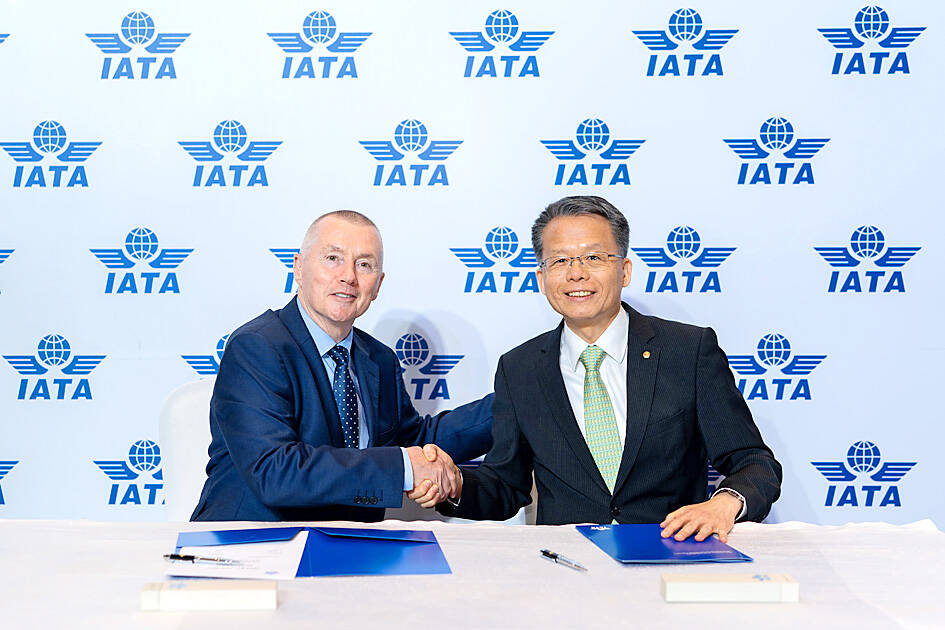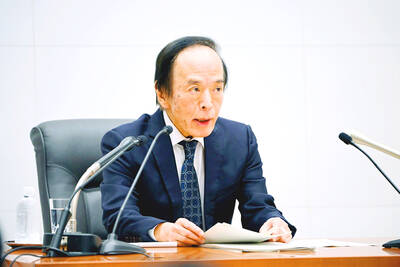EVA Airways Corp (長榮航空) has signed a cooperation agreement with the International Air Transport Association (IATA) to join its Turbulence Aware platform, aiming to improve flight safety through real-time data sharing.
“We believe that joining Turbulence Aware will help pilots and dispatchers to analyze real-time data, plan and choose appropriate flight paths to avoid areas with higher turbulence risks, and ensure the safety of passengers and aircraft,” EVA Airways president Clay Sun (孫嘉明) said yesterday.
The agreement was signed by Sun and IATA director-general Willie Walsh on Sunday during the IATA’s annual general meeting in New Delhi.

Photo courtesy of EVA Airways Corp
Turbulence has become more frequent due to climate change, posing an increasing challenge to flight safety and operations, Sun said.
“Although technology is becoming more advanced, turbulence is still one of the most difficult weather conditions to predict,” he said, adding that mild turbulence might cause an aircraft to shake, while severe turbulence can cause structural damage to the aircraft.
Walsh welcomed EVA Airways’ inclusion in the initiative, saying the partnership would enhance the capabilities of crew and dispatchers around the world to improve flight safety, fuel efficiency and passenger comfort.
He said participating airlines generated 51.8 million turbulence reports last year — a 35 percent increase from 2023 — highlighting the growing value of data in mitigating turbulence-related risks.
With EVA Airways joining, the platform now includes 28 airlines sharing turbulence data from more than 2,700 aircraft. Once collected, the data is processed and relayed to pilots in real time through visual displays, enabling them to make timely route adjustments and avoid affected areas.
EVA Airways said it would initially deploy 33 Boeing 777-300ER aircraft to contribute to data collection and reporting.

Taiwan’s long-term economic competitiveness will hinge not only on national champions like Taiwan Semiconductor Manufacturing Co. (TSMC, 台積電) but also on the widespread adoption of artificial intelligence (AI) and other emerging technologies, a US-based scholar has said. At a lecture in Taipei on Tuesday, Jeffrey Ding, assistant professor of political science at the George Washington University and author of "Technology and the Rise of Great Powers," argued that historical experience shows that general-purpose technologies (GPTs) — such as electricity, computers and now AI — shape long-term economic advantages through their diffusion across the broader economy. "What really matters is not who pioneers

In a high-security Shenzhen laboratory, Chinese scientists have built what Washington has spent years trying to prevent: a prototype of a machine capable of producing the cutting-edge semiconductor chips that power artificial intelligence (AI), smartphones and weapons central to Western military dominance, Reuters has learned. Completed early this year and undergoing testing, the prototype fills nearly an entire factory floor. It was built by a team of former engineers from Dutch semiconductor giant ASML who reverse-engineered the company’s extreme ultraviolet lithography (EUV) machines, according to two people with knowledge of the project. EUV machines sit at the heart of a technological Cold

TAIWAN VALUE CHAIN: Foxtron is to fully own Luxgen following the transaction and it plans to launch a new electric model, the Foxtron Bria, in Taiwan next year Yulon Motor Co (裕隆汽車) yesterday said that its board of directors approved the disposal of its electric vehicle (EV) unit, Luxgen Motor Co (納智捷汽車), to Foxtron Vehicle Technologies Co (鴻華先進) for NT$787.6 million (US$24.98 million). Foxtron, a half-half joint venture between Yulon affiliate Hua-Chuang Automobile Information Technical Center Co (華創車電) and Hon Hai Precision Industry Co (鴻海精密), expects to wrap up the deal in the first quarter of next year. Foxtron would fully own Luxgen following the transaction, including five car distributing companies, outlets and all employees. The deal is subject to the approval of the Fair Trade Commission, Foxtron said. “Foxtron will be

INFLATION CONSIDERATION: The BOJ governor said that it would ‘keep making appropriate decisions’ and would adjust depending on the economy and prices The Bank of Japan (BOJ) yesterday raised its benchmark interest rate to the highest in 30 years and said more increases are in the pipeline if conditions allow, in a sign of growing conviction that it can attain the stable inflation target it has pursued for more than a decade. Bank of Japan Governor Kazuo Ueda’s policy board increased the rate by 0.2 percentage points to 0.75 percent, in a unanimous decision, the bank said in a statement. The central bank cited the rising likelihood of its economic outlook being realized. The rate change was expected by all 50 economists surveyed by Bloomberg. The